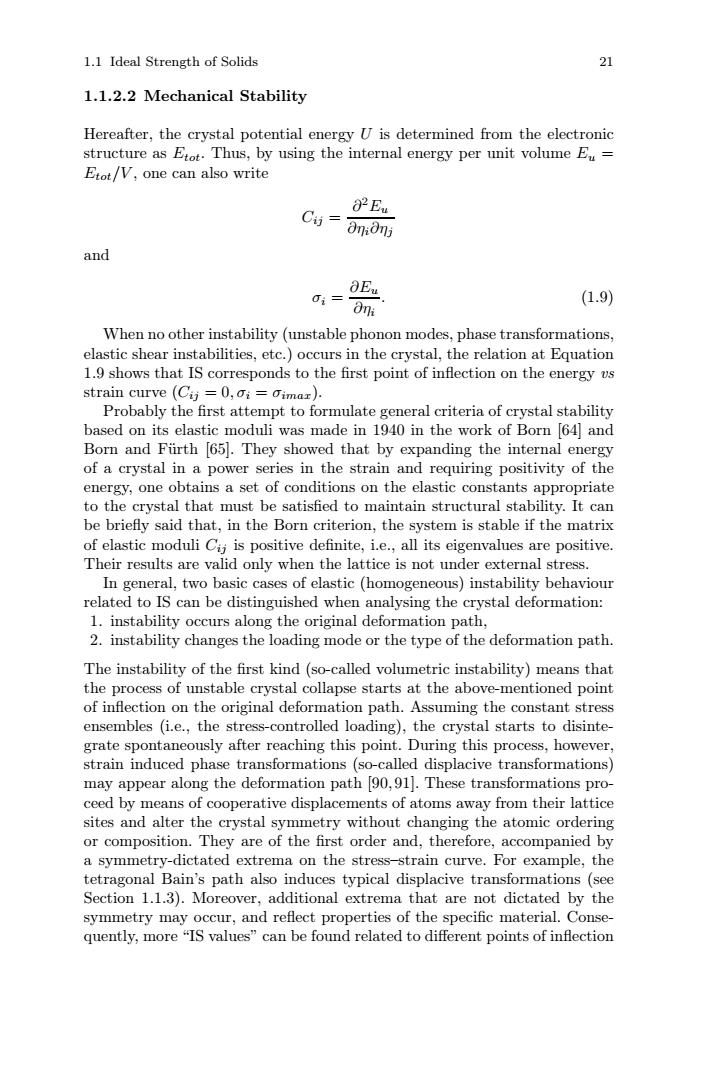正在加载图片...

1.1 Ideal Strength of Solids 21 1.1.2.2 Mechanical Stability Hereafter,the crystal potential energy U is determined from the electronic structure as Etot.Thus,by using the internal energy per unit volume E= Etot/V,one can also write 82Eu Ci)二0m0ni and 8Eu 0:=1 Oni (1.9) When no other instability(unstable phonon modes,phase transformations, elastic shear instabilities,etc.)occurs in the crystal,the relation at Equation 1.9 shows that IS corresponds to the first point of inflection on the energy vs strain curve (Cij=0,0i=dimar). Probably the first attempt to formulate general criteria of crystal stability based on its elastic moduli was made in 1940 in the work of Born 64 and Born and Fiirth [65].They showed that by expanding the internal energy of a crystal in a power series in the strain and requiring positivity of the energy,one obtains a set of conditions on the elastic constants appropriate to the crystal that must be satisfied to maintain structural stability.It can be briefly said that,in the Born criterion,the system is stable if the matrix of elastic moduli Cij is positive definite,i.e.,all its eigenvalues are positive. Their results are valid only when the lattice is not under external stress. In general,two basic cases of elastic (homogeneous)instability behaviour related to IS can be distinguished when analysing the crystal deformation: 1.instability occurs along the original deformation path, 2.instability changes the loading mode or the type of the deformation path. The instability of the first kind (so-called volumetric instability)means that the process of unstable crystal collapse starts at the above-mentioned point of inflection on the original deformation path.Assuming the constant stress ensembles (i.e.,the stress-controlled loading),the crystal starts to disinte- grate spontaneously after reaching this point.During this process,however, strain induced phase transformations (so-called displacive transformations) may appear along the deformation path [90,91].These transformations pro- ceed by means of cooperative displacements of atoms away from their lattice sites and alter the crystal symmetry without changing the atomic ordering or composition.They are of the first order and,therefore,accompanied by a symmetry-dictated extrema on the stress-strain curve.For example,the tetragonal Bain's path also induces typical displacive transformations(see Section 1.1.3).Moreover,additional extrema that are not dictated by the symmetry may occur,and reflect properties of the specific material.Conse- quently,more"IS values"can be found related to different points of inflection1.1 Ideal Strength of Solids 21 1.1.2.2 Mechanical Stability Hereafter, the crystal potential energy U is determined from the electronic structure as Etot. Thus, by using the internal energy per unit volume Eu = Etot/V , one can also write Cij = ∂2Eu ∂ηi∂ηj and σi = ∂Eu ∂ηi . (1.9) When no other instability (unstable phonon modes, phase transformations, elastic shear instabilities, etc.) occurs in the crystal, the relation at Equation 1.9 shows that IS corresponds to the first point of inflection on the energy vs strain curve (Cij = 0, σi = σimax). Probably the first attempt to formulate general criteria of crystal stability based on its elastic moduli was made in 1940 in the work of Born [64] and Born and F¨urth [65]. They showed that by expanding the internal energy of a crystal in a power series in the strain and requiring positivity of the energy, one obtains a set of conditions on the elastic constants appropriate to the crystal that must be satisfied to maintain structural stability. It can be briefly said that, in the Born criterion, the system is stable if the matrix of elastic moduli Cij is positive definite, i.e., all its eigenvalues are positive. Their results are valid only when the lattice is not under external stress. In general, two basic cases of elastic (homogeneous) instability behaviour related to IS can be distinguished when analysing the crystal deformation: 1. instability occurs along the original deformation path, 2. instability changes the loading mode or the type of the deformation path. The instability of the first kind (so-called volumetric instability) means that the process of unstable crystal collapse starts at the above-mentioned point of inflection on the original deformation path. Assuming the constant stress ensembles (i.e., the stress-controlled loading), the crystal starts to disintegrate spontaneously after reaching this point. During this process, however, strain induced phase transformations (so-called displacive transformations) may appear along the deformation path [90, 91]. These transformations proceed by means of cooperative displacements of atoms away from their lattice sites and alter the crystal symmetry without changing the atomic ordering or composition. They are of the first order and, therefore, accompanied by a symmetry-dictated extrema on the stress–strain curve. For example, the tetragonal Bain’s path also induces typical displacive transformations (see Section 1.1.3). Moreover, additional extrema that are not dictated by the symmetry may occur, and reflect properties of the specific material. Consequently, more “IS values” can be found related to different points of inflection